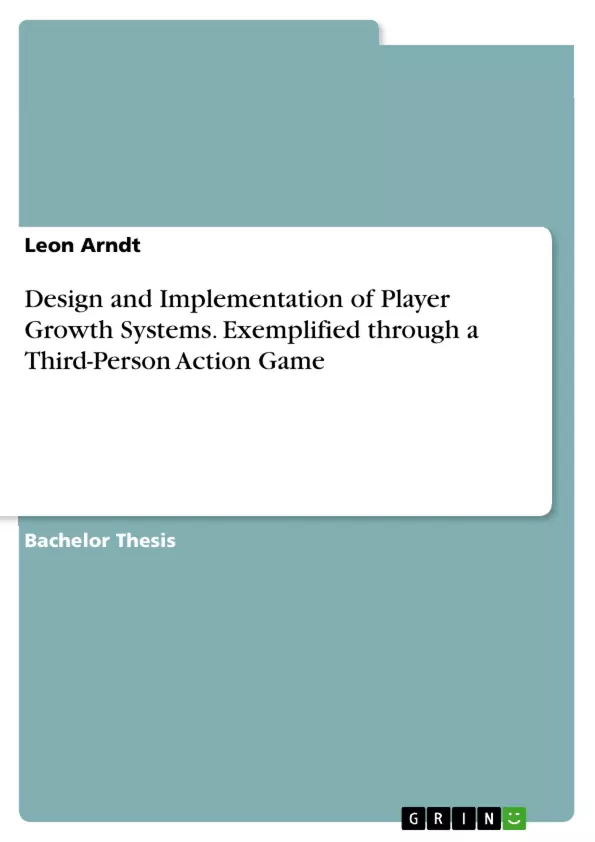
Design and Implementation of Player Growth Systems. Exemplified through a Third-Person Action Game
Bachelorarbeit, 2020
139 Seiten, Note: 1.3
Leseprobe
Inhaltsverzeichnis (Table of Contents)
- Abstract
- Table of Contents
- 1. Project Introduction
- 1.1 Individual Goal
- 1.2 Relevance
- 1.2.1 Player Growth Systems
- 1.2.2 The Power of Growth as a Game Mechanic
- 1.2.3 Method: Experimental Nature of Relume
- 1.3 Outline
- 2. State of the Art - Literature Review
- 2.1 Defining Black and White Thinking
- 2.2 Systems Theory
- 2.3 Player vs. Player Character
- 3. The Design of Player Growth Systems
- 3.1 Definition of Player Growth
- 3.2 Visual Growth
- 3.2.1 Visual Growth Definition
- 3.2.2 Background
- 3.2.3 Examples
- 3.3 Player Ability Growth
- 3.3.1 Definition
- 3.3.2 Background
- 3.3.3 Examples
- 3.4 Emotional Growth
- 3.4.1 Definition
- 3.4.2 Background
- 3.4.3 Examples
- 3.5 Growth Related to Audio
- 3.5.1 Definition
- 3.5.2 Background
- 3.5.3 Examples
- 3.6 Combining multiple aspects of Player Growth
- 3.7 Player Regression
- 3.8 Growth Plateauing
- 3.9 Summary of Growth Elements
- 4. Methods as Applied to the Project (Implementation)
- 4.1 Why Third Person Action Games?
- 4.2 Growth Systems Outline
- 4.3 Growth Unlock Structure
- 4.4 Growth Mechanics instead of Violence
- 4.5 Movement in Relume
- 4.6 Storytelling: Emotional Growth
- 4.7 Player Narrative
- 4.8 Combat in Relume
- 4.9 Dancing in Relume
- 4.10 Teaching Growth Mechanics to Player
- 4.11 Summary of Growth Systems in Relume
- 5. Technical Implementation
- 5.1 Visual Player Growth
- 5.2 Player Abilities
- 5.3 Animations
- 5.4 Audio Programming
- 5.5 Teaching and Communicating Mechanics
- 5.6 Contributed Assets
- 6. Measurement Approach
- 6.1 General Playtests
- 6.2 Reworked Thesis Testing
- 6.3 Online Growth Testing
- 6.4 Questionnaire Comparison
- 6.5 Measuring Engagement through Analytics
- 7. Data Results
- 7.1 Early Survey
- 7.2 Late Production Survey
- 7.3 Online Growth Survey
- 7.4 Unity Analytics
- 8. Data Evaluation
- 8.1 Connection to Bachelor Goal
- 8.2 Survey Methodology
- 9. Player Growth Discussion
- 9.1 Conclusions for Player Growth Systems based on Results
- 9.2 Limitation of Player Growth Systems
- 9.3 Inherent Problems of Player Growth Systems
- 10. Project Reflection
- 10.1 Missing Research
- 10.2 Lessons Learned
- 10.3 Team Evaluation
Zielsetzung und Themenschwerpunkte (Objectives and Key Themes)
This thesis investigates player growth systems in video games, focusing on their design, implementation, and impact on gameplay. It explores the importance of growth as a core game mechanic and examines how different aspects of player growth, including visual, ability, and emotional development, can be integrated into game design. The project utilizes a third-person action game, Relume, as a case study to demonstrate the practical application of these concepts. This study aims to provide a framework for understanding player growth systems and to contribute to the development of engaging and enriching gameplay experiences.
- Player growth systems in video games
- The importance of growth as a game mechanic
- Design and implementation of player growth systems
- Impact of player growth systems on engagement and gameplay
- Case study using a third-person action game (Relume)
Zusammenfassung der Kapitel (Chapter Summaries)
This thesis begins by introducing the project and its goals. The project aims to analyze player growth systems and implement them in a third-person action game called Relume. Chapter 2 provides a literature review, exploring relevant concepts such as black and white thinking, systems theory, and the distinction between player and player character. Chapter 3 focuses on the design of player growth systems, defining and analyzing different aspects of growth, including visual, ability, emotional, and audio-based growth. The chapter also discusses combining multiple aspects of growth and addressing issues like player regression and growth plateauing. Chapter 4 delves into the specific implementation of player growth systems in the Relume project. This includes outlining the overall structure, exploring the game's mechanics, and showcasing how growth mechanics are integrated into the game's combat, movement, and storytelling.
Chapter 5 details the technical implementation of the player growth systems, covering areas like visual growth, player abilities, animations, audio programming, and communication of game mechanics to players. Chapter 6 outlines the measurement approach used to assess the impact of the player growth systems. This involves various testing methods, including general playtests, online growth testing, and questionnaires. Chapter 7 presents the data results from the various tests conducted, focusing on early survey data, late production survey data, online growth survey results, and data collected through Unity analytics. Chapter 8 evaluates the data results and discusses their connection to the thesis goals, exploring survey methodology and data analysis techniques.
Chapter 9 delves into a discussion of the findings regarding player growth systems, drawing conclusions based on the data analysis and highlighting limitations of player growth systems. It also addresses inherent problems that arise in their implementation. Chapter 10 reflects on the project as a whole, discussing areas of missing research, lessons learned throughout the development process, and evaluating the team's performance.
Schlüsselwörter (Keywords)
This thesis focuses on player growth systems, analyzing their design, implementation, and impact on gameplay, with a particular focus on third-person action games. Key concepts include visual, ability, and emotional growth, as well as the interplay between player and player character. The study utilizes the Unity game engine for implementation and investigates the impact of growth mechanics on player engagement and gameplay structure through user testing and analytics.
Details
- Titel
- Design and Implementation of Player Growth Systems. Exemplified through a Third-Person Action Game
- Hochschule
- Hochschule Darmstadt
- Veranstaltung
- Animation & Game
- Note
- 1.3
- Autor
- Leon Arndt (Autor:in)
- Erscheinungsjahr
- 2020
- Seiten
- 139
- Katalognummer
- V540558
- ISBN (eBook)
- 9783346196941
- ISBN (Buch)
- 9783346196958
- Sprache
- Englisch
- Schlagworte
- action design exemplified game growth implementation player systems third-person
- Produktsicherheit
- GRIN Publishing GmbH
- Preis (Ebook)
- US$ 39,99
- Preis (Book)
- US$ 50,99
- Arbeit zitieren
- Leon Arndt (Autor:in), 2020, Design and Implementation of Player Growth Systems. Exemplified through a Third-Person Action Game, München, Page::Imprint:: GRINVerlagOHG, https://www.diplomarbeiten24.de/document/540558
- Autor werden
- Ihre Optionen
- Vertriebskanäle
- Premium Services
- Autorenprofil
- Textarten und Formate
- Services für Verlage, Hochschulen, Unternehmen

- © GRIN Publishing GmbH.
- Alle Inhalte urheberrechtlich geschützt. Kopieren und verbreiten untersagt.
- info@grin.com
- AGB
- Open Publishing
Der GRIN Verlag hat sich seit 1998 auf die Veröffentlichung akademischer eBooks und Bücher spezialisiert. Der GRIN Verlag steht damit als erstes Unternehmen für User Generated Quality Content. Die Verlagsseiten GRIN.com, Hausarbeiten.de und Diplomarbeiten24 bieten für Hochschullehrer, Absolventen und Studenten die ideale Plattform, wissenschaftliche Texte wie Hausarbeiten, Referate, Bachelorarbeiten, Masterarbeiten, Diplomarbeiten, Dissertationen und wissenschaftliche Aufsätze einem breiten Publikum zu präsentieren.
Kostenfreie Veröffentlichung: Hausarbeit, Bachelorarbeit, Diplomarbeit, Dissertation, Masterarbeit, Interpretation oder Referat jetzt veröffentlichen!
- GRIN Verlag GmbH
-
- Nymphenburger Str. 86
- 80636
- Munich, Deutschland
- +49 89-550559-0
- +49 89-550559-10
- info@grin.com
-









